I have a sample project at https://github.com/jh3010-qt-questions/large_qrc
If I run the app from Qt Creator, I get a window which looks like the one below.
However, if I package the app with linuxdeployqt, only the bottom image on the window displays. It is loaded directly from disk. The top image is from a .qrc which should have been attached to the executable, but it does not appear.
My directory structure follows the recommendation from linuxdeployqt
$ tree usr
usr
├── bin
│ ├── image_assets
│ │ └── original_image_png
│ └── large_qrc
├── lib
└── share
├── applications
│ └── large_qrc.desktop
└── icons
└── hicolor
└── 256z256
└── apps
└── large_qrc.png
I build the app image by doing:
linuxdeployqt usr/share/applications/large_qrc.desktop -appimage -qmake=/home/jamesh/Qt5.12.10/5.12.10/gcc_64/bin/qmake -qmldir=/home/jamesh/depot_qt/questions/large_qrc
I can double click on the resulting large_qrc-x86_64.AppImage executable from the Ubuntu GUI. The application launches successfully, but the top image does not show up.
What needs to be changed so QML Image can access the image in the .qrc?
A secondary question is whether or not there is a better way to handle the images in image_assets. It seems a bit odd to copy them into the bin folder, but perhaps that is a best practice in this situation.
If it matters, I am using Ubuntu 20.04
My project file is:
QT += quick
CONFIG += c++11
image_assets.files = $$PWD/image_assets
image_assets.path = $$OUT_PWD
COPIES += image_assets
SOURCES += \
main.cpp
RESOURCES += qml.qrc
# Additional import path used to resolve QML modules in Qt Creator's code model
QML_IMPORT_PATH =
# Additional import path used to resolve QML modules just for Qt Quick Designer
QML_DESIGNER_IMPORT_PATH =
# Default rules for deployment.
qnx: target.path = /tmp/$${TARGET}/bin
else: unix:!android: target.path = /opt/$${TARGET}/bin
!isEmpty(target.path): INSTALLS += target
qml.qrc
<RCC>
<qresource prefix="/">
<file>main.qml</file>
<file>drawing.svg</file>
</qresource>
</RCC>
main.qml
import QtQuick 2.12
import QtQuick.Window 2.12
Window {
width: 640
height: 480
visible: true
title: qsTr("Hello World")
Column {
Image {
width: 200
height: 200
fillMode: Image.PreserveAspectFit
source: "qrc:drawing.svg"
}
Image {
width: 200
height: 200
fillMode: Image.PreserveAspectFit
source: "file:///" + applicationDirPath + "/image_assets/original_image_png"
}
}
}
main.cpp
#include <QGuiApplication>
#include <QQmlApplicationEngine>
#include <QQmlContext>
int main(int argc, char *argv[])
{
QCoreApplication::setAttribute(Qt::AA_EnableHighDpiScaling);
QGuiApplication app(argc, argv);
QQmlApplicationEngine engine;
engine.rootContext()->setContextProperty( "applicationDirPath", QGuiApplication::applicationDirPath() );
const QUrl url(QStringLiteral("qrc:/main.qml"));
QObject::connect(&engine, &QQmlApplicationEngine::objectCreated,
&app, [url](QObject *obj, const QUrl &objUrl) {
if (!obj && url == objUrl)
QCoreApplication::exit(-1);
}, Qt::QueuedConnection);
engine.load(url);
return app.exec();
}
large_qrc.desktop
[Desktop Entry]
Type=Application
Name=large_qrc
Comment=The best Qt Application Ever
Exec=large_qrc
Icon=large_qrc
Categories=Office;
This should be the output and is when I run the program from Qt Creator.
